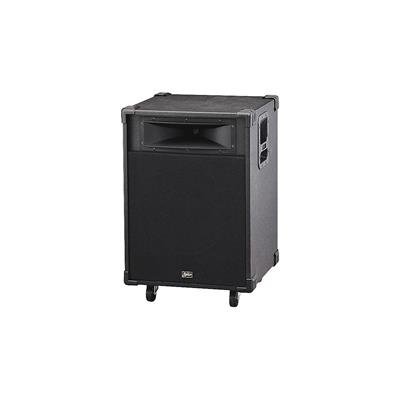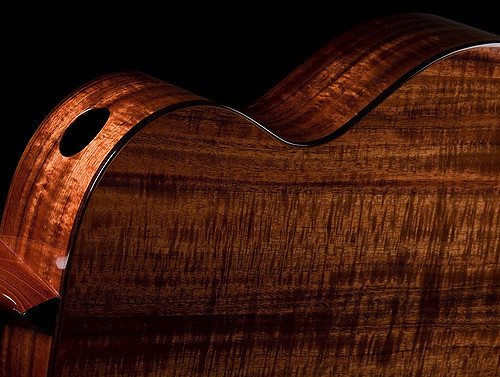
When I was a kid of about 8 years old I saw a cartoon, I think it was a looney tunes one, where a character, after some hijinks, was put into jail. The moment the cartoon got behind bars, it started playing a harmonica. In that moment I realized I wanted one.
My father, being the reasonable he is, bought me one a few days later as a reward for getting good grades in school. I am sure even to today, if you ask him about it, he will tell you how it was one of the worst decisions of his life. Just like any kid of that age, I did not waste any time trying to actually learn to play it. Instead, I put it in my mouth and started producing the most annoying, ceaseless sounds that anyone had ever heard. I did not let go of it for several days.
I pretended to be some kind of criminal playing the harmonica, while marching around the house, street, and school. I was probably the most hated kid by parents, neighbors, teachers, and basically anyone with ears and a brain to be annoyed. Thankfully, being a child, I grew bored of the instrument eventually (it took me too long if you ask my father). It was thrown, as toys tend to be, into the back of a chest to gather dust in darkness. It would only be years later that I would pick it up again. My growing interest in blues would be the motivator. Unfortunately, it had rusted over the years. So I decided to buy the best harmonica I could at the time, to annoy people once again. This time though, I would learn to play.
What’s The Best Harmonica
Hohner Marine Band Special 20 5-Piece Pro Pack
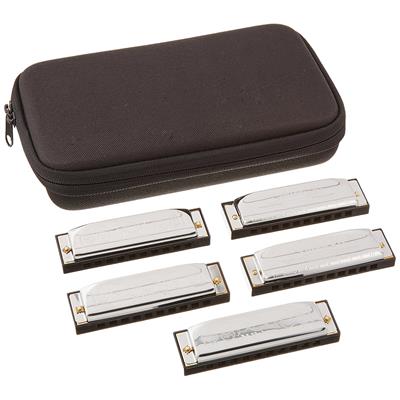
Have you ever heard a marine band perform? I have. These men (and women) have been whipped into shape by the waves of the sea. They understand the importance of pitch-perfect, which is why they are always on time, always perform their tasks well and demand perfection both of themselves and their instruments. I know that for a fact since, well, I have had a few friends in the navy. They can be unbearable (no offense) but they are also a great asset in any field, especially music. The Hohner Marine Band Special 20 5-piece pro pack was made for people with the same standards as the Marines, and it reflects in the quality of the instruments that come in the pack. You get 5 diatonic harmonicas in the keys of G, A, C, D, E, and all of them sound amazing. Conforming to the marine standard is not easy, but when achieved, yields amazing results.
Pros:
- Great pack value
- Amazing tone
- Comfortable for beginners
- Space for more harmonicas in a case
Cons:
- Might require some adjustment
- Not the highest quality material used for case
Hohner Special 20 Harmonica, Major C
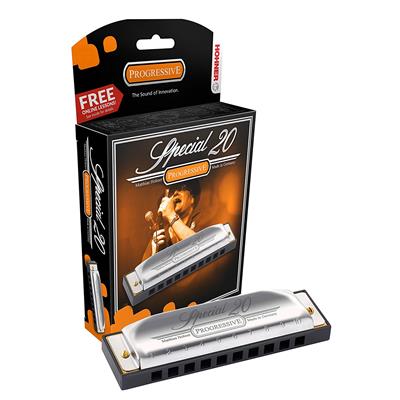
If you don’t like the expensive pro pack, you can buy just one harmonica instead. The C key is great for both beginners and pros. This 20-hole harmonica is special and will help you improve your skills. This diatonic harmonica is sturdy and built to last as long as the brass will allow it to. It has a plastic body that goes easy on your lips as you play and allows for issue-less high-speed playing. This is a high-quality harmonica manufactured in Germany and the sound is just as high quality as you would expect of Hohner’s century-and-a-half-old manufacturing experience. While this might not the marine band type, the Special 20 Major C provides you with a great sound and is the best harmonica for beginners to buy first.
Pros:
- No sharp edges
- Replaceable reeds
- Rich sound
Cons:
- A bit expensive for beginners
- Inconsistency with models
SWAN Stainless Steel Chromatics Harmonica SW1040
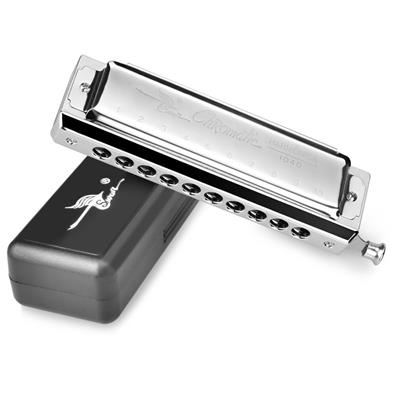
The SWAN stainless Steel Chromatics Harmonica SW1040 is different from the two Hohners, and the majority of harmonicas, discussed on this list. First of all, it is a chromatic harmonica, meaning that you get way more versatility at the cost of a harder-to-play instrument. With a chromatic harmonica, your ability to go through keys and sounds is enhanced. This harmonica though is slightly easier to manipulate thanks to intelligent construction. The sound this instrument produces is clear, strong and very much a head-turner in any situation. The high-quality make of this harmonica make it a long-term investment, with the engineering, the reeds and the plastic of the body remaining unscathed for years after purchase. Overall, this is one of the best harmonicas made on the market today and if you are looking for something more advanced than a diatonic harmonica, this would be the way to go.
Pros:
- Good price
- Rich sound
- Smooth
Cons:
- Not the best volume
- Quality check (bad reeds on some models)
Lee Oskar Harmonica, Key of C, Major Diatonic
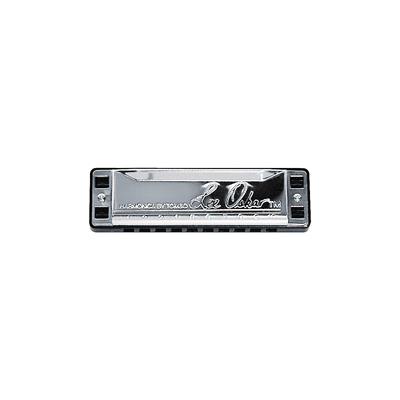
Have you ever sat in a roofless car on a day where the sun laid down heavily on the street? The heat rising off of the pavement as the warm breeze from the ocean somewhere close by blows towards the east, as you and your buddies ride through the neighborhood in your low rider? Then you have, unwittingly, performed the live incarnation of the song that Lee Oskar performed on his harmonica. So many years later, he has produced one of the best harmonicas around for the purpose of you being able to play the song while you reenact it. Lee Oskar Diatonic Harmonica, Major key of C is an incredible instrument. Extremely well built with high-quality plastic and even higher quality brass reeds, the instrument produces a very vibrant sound that you will grow as attached to as you grew to the Low Rider song. This is the best harmonica for beginners or professionals alike, providing everything both types of players would needs or want.
Pros:
- Airtight design
- Replaceable reeds
- Consistent quality
- Great tone
- Comfortable
Cons:
- A bit pricey
Fender Blues Deluxe Harmonica, Key of C
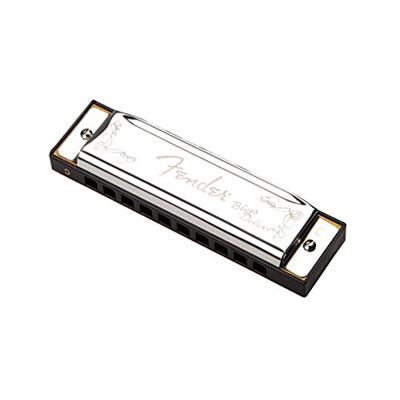
To all you fanboys who did not know, Fender is not exclusively a guitar manufacturer. Yes they produce a number of different types of guitar, but they are also known to produce a number of guitar accessories, one of which is, you guessed it, the harmonica. Why it is categorized as an accessory is a mystery to me, though the instrument has been treated as a toy or an accessory many times in its history. I guess its simplicity and affordability do not qualify it as a full instrument to some. Whatever it is, the Fender Blues Deluxe Harmonica in the key of C is an extremely well made instrument. Fender might not respect the instrument as such, but they definitely know how to make one. One of the best cheap diatonic harmonicas available on the market, this instrument is also one of the best harmonicas for blues. It is easy to play, is of sturdy make and highly susceptible to playing techniques, especially overblowing, that you will be using on it.
Pros:
- Great for beginners
- Comfortable
- Inexpensive
Cons:
- Sharp edges
- Not loud enough
Johnson BK-520-C Blues King Harmonica, C

If you are having trouble with the price of the harmonicas up to this very point, then I have something that you might find exciting. Johnson BK-520-C is priced well under what the average best harmonica on this list and despite it being part of it, you can still see that the quality of the instrument suffers with the price. This instrument is a solid entry into the list of harmonicas that have existed but by no way does it have right to call itself king. The design is not air-tight, resulting in most of the air you blow through escaping without agitating the reeds. This causes the harmonica to be less responsive than its counterparts on the list. Still, if you are looking for an entry level harmonica that is worth less than a coffee at Starbucks, then you might find this one to be the perfect candidate for you.
Pros:
- Very affordable
- Great playability
- Spot on tone
Cons:
- Loses air
- Not very responsive
Anwenk Harmonica Key of C 10 Hole 20 Tone Diatonic Harmonica
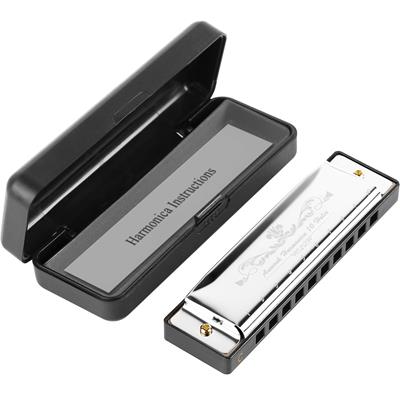
Some people say that style over substance is the only way to go about living. Those very same people are usually delighted to find out that it is possible to have both, without sacrificing the other. The Anwenk Harmonica Key of C 10 Hole Diatonic Harmonica is one item that would cause such people immense happiness. This instrument combines incredible style, one that stands out on the list, with a solid make and sound. The phosphor bronze reeds of this harmonica are highly corrosion-resistant, which means that you will not have to change them for a long time. The thick cover plate provides sound stability, as well as good integrity to the structure of the instrument. The comb is food grade resin, which compared to plastic is not as smooth, but this harmonica remains easy to play despite this. The sound it produces trumps many on the list, making it one of the best sounding harmonicas on the market.
Pros:
- Inexpensive
- Good start for a beginner
- Clear Tone
Cons:
- Resin comb
- Air leakage
- Not the highest quality
Suzuki HA-20-C 10-Hole Diatonic Harmonica
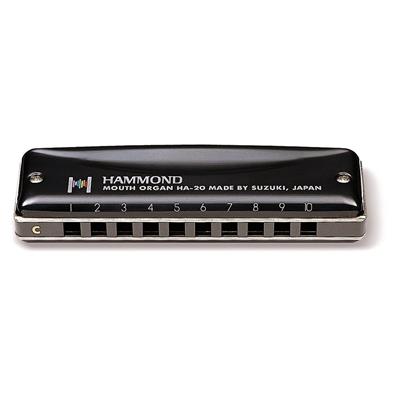
The hammond organ is an impressive instrument capable of musical feat that many instruments would break at the thought of. The make of the organ is always quality and always made with the thought that it will need to last for decades. So to have the option of buying a harmonica that bears the name of the legendary company producing the organs is a miracle. The harmonica itself is of impeccable make. The comb is sturdy and very comfortable to travel along. The cover plates reinforce the sound that the reeds make beautifully, while the replaceable reeds themselves made with great care and produce the most impressive sound. While it is not fair to compare a harmonica to an organ, it would not be over the top to say that having one of the Suzuki HA-20-C diatonic harmonicas does feel like you have the power of an organ with you when you play it.
Pros:
- Great looks
- Responsive
- Rich sound
Cons:
- Expensive for beginners
- Might be a bit heavy
PLCEO Folkmaster Standard 10-Hole Diatonic Harmonica
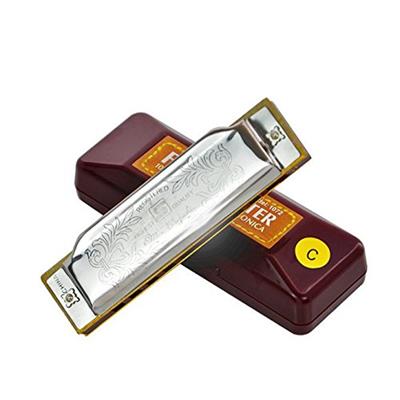
The harmonica has played an enormous role in the development of folk culture in the United States and Canada. The moment it arrived on North American soil, the instrument became integral to the musical culture of the new land. The poor families traveling west, looking for homesteads often brought harmonicas with them, playing these versatile, cheap instruments in ways that would eventually become the folk and country music so revered in the modern American culture. It is refreshing to see that an instrument manufacturer is honoring the age old tradition of well made, affordable harmonicas, dedicated to the purpose of playing folk music. The PLCEO Folkmaster Standard Diatonic harmonica produces a great, nostalgic sound that, despite not standing up to the best on this list, stands in its own category as one of the best sounds. The construction of this harmonica is sturdy, with brass reeds and a comfortable plastic comb. This is one of the best affordable diatonic harmonicas.
Pros:
- Affordable
- Nice looks
- Rich sound
Cons:
- Sharp edges
- Not that airtight
SEYDEL Blues Session Steel Key of C Harmonica
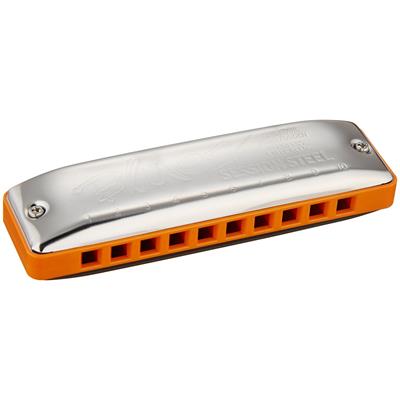
An instrument does not need to be flashy to perform beyond what any other instrument in its category is capable of. While style may be an important addition, the quality of the instrument is what defines how useful it is to a musician. The SEYDEL Blues Session Steel Harmonica in the key of C is one of those minimalist instruments that revel in looking underwhelming and produce a sound so overwhelming, people will be wondering “what that was” for days to come. The rounded cover pieces create extra comfort around the already smooth plastic comb of the harmonica, making traveling along with it easy. The reeds are fine cut and the design of the harmonica is air tight, meaning that you will be a minimal amount of air to produce a sound that is seemingly perfect. This is the best harmonica to buy, possibly in the history of harmonicas.
Pros:
- Ergonomic
- Durable
- Low air consumption
Cons:
- Design (a.k.a not a big fan of orange comb)
- For beginners, the price might be a bit high
History of harmonica
The harmonica is an amazing instrument. Simple but versatile, the harmonica in its current form has existed for about 200 years. It has found uses in many contexts, including the orchestra. But its most recent role in the world of modern music has become one of its best. But the history of the Harmonica is deep and, in a way, very important to the development of American culture.
The first harmonica-like instruments existed in southeast Asia for thousands of years before reaching Europe. These were called Sheng and looked way different to what the Harmonicas of today look like. Though the idea was pretty much the same – holes that you blow through that vibrate reeds, which in turn, produces the sound. When comparing the sound of the Sheng to that of the modern Harmonica, it is possible to hear the similarity between the instruments. So much so, that it makes sense how the Sheng could have inspired the modern harmonica that was developed in Europe during the 19th century.
Joseph Richter, in the mid 1820s, created the first prototype of the modern harmonica. The technology allowed for the instrument to be played both when breathing out and in. Once the creation was let loose on the people, the harmonica became popular at an incredible speed. The people, seeing the instrument, would copy it and make their versions. The small size and the unique sound the instrument produced made it very popular with anyone looking to have music available to them at all times. Then, in 1857, the now most well known producer of harmonicas, Hohner, got to making harmonicas. He was soon mass-producing them and became the most successful harmonica maker at the time and up to today.
One of the reasons that Hohner became so successful in the Harmonica manufacturing business was North America. He shipped some of the first Harmonicas he ever made to his relatives in the United States, where the instrument gained a lot of momentum. Everybody wanted one because it was cheap, light and sounded very good. Suddenly, Hohner had discovered an untapped market, and he tapped into it hard. Over the next few decades the Harmonica would become one of the staple instruments in American culture. Part of the sound of what we imagine to be the wild west, it soon evolved into the instrument of choice for blues and jazz musicians. It would go on to raise from being a poor man’s instrument to being used to perform classical musical pieces in the 1930s.
Today the harmonica is a widely respected and loved instrument. Most often represented in the blues and jazz genres, you can hear it being used in rock and roll as often as you can hear it in country and bluegrass songs. Its presence across all genres of music is slightly ironic and a great contrast to how this instrument was once underestimated.
Types of harmonica
There are many different types of harmonicas available to buy. The standard harmonica, diatonic, is the one you think of when you imagine yourself playing with a blues ensemble. There are other types of harmonicas, most of them different in sound and play, as well as the complexity of how they are played.
Diatonic Harminica
This type of harmonica is most commonly found in the blues and pop genres. Having ten holes, each with two reads, these harmonicas are usually limited to one key. Though playing techniques are available that allow the player to go beyond what the label says is available. The variety and affordability of diatonic models gives you the ability to quickly expand your collection and grow comfortable with certain types of models.
Chromatic Harmonica
Chromatic harmonicas have 12 holes in them, each with two reeds and a manually worked lever that switches between the two reeds. This makes the chromatic harmonica considerably harder to play than the diatonic, but also gives the flexibility that allows the master musician to play just about any scale. The reeds of the chromatic are also harder to bend, meaning they are hard to play effectively or overblow, but if done right, the sound produced is very rich and full.
Tremolo
Tremolo harmonicas are built to sound very different from the other options available on the market. Each hole plays two reeds at the same time, one tuned sharp, the other flat, producing a very unique and recognizable sound. These are very popular in Japan but did not catch on too well in the United States or Europe.
There are also harmonicas manufactured for specific purposes. While less popular, these harmonicas present great utility in certain situations. Referred to as specialty harmonicas, here are some examples:
Specialty Harmonicas
- Chord Harmonicas
-
- These harmonicas are huge. They have the ability to produce 48 different chords and are arrange so that there are clusters of four chords all along it. I would have a hard time finding a role for them in a band, but they do have a use: they provide melodic support in harmonica ensembles (yes those exist)
- Orchestral Harmonicas
-
- These are made both in diatonic and chromatic versions and are produced in a number of pitches. Their purpose is to be part of, you guessed it, orchestral groups. This means they have a powerful sound so they can keep up with the rest of the instruments.
Though on this list you will only find Diatonic Harmonicas.
Diatonic harmonicas are made in several different keys. Any beginner will the C key most useful to them, since it is the most pleasant to listen to and the easiest to play and learn on. Eventually, once the beginner becomes more advanced in their playing, they will expand their repertoire of keys. If playing in ensemble with a guitar, these keys will usually be D, F, G, A, to complement the sound of the guitar.
Harmonica Techniques
There are several techniques used in playing the harmonica that will result in your music sounding better, more mature and professional. While some of these may seem intuitive, performing these techniques consciously will be an improvement on simply performing them accidentally.
Bending
Bending is a technique that involves adjusting your “embouchure”, or in human speak, how you are using your lips, teeth, tongue and the rest of your mouth muscles to play the harmonica. This technique is hard to master, especially for beginners, but once mastered is one of the more satisfying to use. It allows you to play beyond the 19 notes readily available on your harmonica, giving you range beyond the key that your instrument is in.
Overbending
Is a technique related to bending (as the name would imply) but is also harder to achieve and requires that a harmonica be modified to a certain extent to make it possible? When modified correctly and the overbending is achieved, the player becomes able to play higher-pitched notes than what he would be able to do normally or with bending techniques.
Tongue Blocking, Lip Pursing
If you are putting your mouth over three or more holes at the same time, this technique will allow you to isolate a single hole at a time. This is an alternative to Lip Pursing, which requires you to place your mouth over a single hole at a time by pursing your lips.
Best Harmonica Brands
Hohner
The brand that you’ll encounter most frequently while searching the market for harmonicas is Hohner and that happens for a reason. This company was founded back in 1857 by Matthias Hohner. Since the very beginning, they have focused on folk instruments and their production. Their range includes harmonicas, accordions, and melodicas – giving folk musicians a lot of options to choose from. Their harmonicas are particularly popular and ubiquitous – be it a more affordable range or a high-end market, the chances are they will be featured in the top picks. The concept behind this brand is simple: they want to do everything in order to help you create music, and thus live. This idea is felt through their products and their quality. Unless you truly believe in everything you do, it’s really hard to succeed. After considering that, it’s not surprising that Hohner has been occupying a leading role on the harmonica market. They offer anything from beginner to diatonic to orchestra, chromatic, signature and tremolo. You can find a suitable piece regardless of the level of your craftsmanship, because they have got everyone covered. People often think that harmonicas don’t require that much quality as they are generally cheap, but trust me, the difference between inexpensive and well-made models is dramatic. That’s why it’s always a good idea to look up items that are created by reliable brands, such as Hohner.
Seydel
If we’re talking about quality and expertise, then we can’t avoid talking about Seydel. In fact, this brand should be one of the first things we discuss in that context, since they know perfectly well what they are doing. It was founded in 1847 by Christian August Seydel. He and his brother were miners who started to study the production of harmonicas after they became unemployed. After becoming professionals in that sphere, they started up their own company in Klingenthal. The brand quickly turned into the biggest harmonica factory in the whole Saxony. After the death of Christian in 1882, his sons (Richard and Moritz) took over and the company has been called C.A. Seydel and Söhne (meaning C.A. Seydel and sons) ever since. They spread out throughout the whole world and eventually became one of the most distinguished brands when it came to harmonicas. In 2006, they started incorporating stainless steel reeds in their models, enhancing and developing sound even further. Each product is created with love, attention and passion, resulting in something that you’ll keep in your collection for eternity. Seydel is a brand that is synonymous with experience and knowledge since they have had its own ups and downs. Regardless, their team found solutions to every problem, continued doing their job and made sure this historical company would survive. And lucky for us, they are still producing wonderful harmonicas.
Suzuki
No, we’re not talking about a bike company here, because it’s a completely different brand. We’re, however, talking about a renowned harmonica manufacturer which has nothing to do with motorcycles. We should be grateful to Manji Suzuki for the establishment of Suzuki, since he gave birth to wonderful harmonicas. Though the brand has diversified its range, in the beginning harmonicas were the only instruments they manufactured. A business that began in a small room grew larger and stronger day by day. By 1990 it had enough profits to purchase Hammond Organ Company, and, thus, it became part of Suzuki. Today this brand creates and sells a wide range of instruments, including the ones that are purely electronic. However, harmonicas still hold a wide portion of their production. The reason is simple – customers can always rely on their quality. The Japanese craftsmanship is impeccable within this company and the results are always stunning. It will be hard for you to find a crappy small harp from Suzuki, because the majority of their models have exceptional sound.
Lee Oskar
Harmonicas are instruments that tend to seem similar at first glance, but in reality, there are significant differences between each model. That’s why we value brands that offer a wide variety of choices, and always provide us with something new that we can be excited about. Lee Oskar is probably among the companies that you should certainly have in your collection. It was founded by Lee Oskar (you guessed it), who happens to be a prominent harmonica player. It’s not surprising that someone who has played the instrument for a really long time understands it to its core. He did also understand the needs of a player and the standards that a quality harmonica should satisfy. He took all that knowledge and poured it into production. He established the company in 1983 and has been providing players with innovative pieces ever since. Lee Oskar pioneered the interchangeable system of reed plates, combs, and cover plates that eventually became sought after by many. Why would musicians go for their harmonicas? The answer to this question is simple: they are quite affordable and diverse, they have replaceable reed plates, and they emit fantastic sound. They can be used by beginners and advanced players equally without worrying about a thing. Lee Oskar is a brand that shows you what they have, tells you the genre you can use the particular model for, and gives you a lifetime of experience after the purchase.
Fender
I won’t even bore you with the history of Fender, because we all know who they are and why they continue to occupy space in the lists of best instruments and brands. What I will tell you is that they aren’t renowned merely for guitars, basses, and amps. They are rather versatile in terms of their products, which means you can enter their website with nothing and leave with a complete set of equipment. Harmonica is that unexpected instrument that you’ll see on their website. Nowadays they offer two models: Blues DeVille and Blues Deluxe. These can be found individually or within sets, enabling you to purchase diatonic harmonicas in all the keys that you’ll need for playing. It’s fair to say that their small harps are extremely affordable, allowing beginners to enjoy the treat without spending too much. Fender harmonicas are simple and usable – they have all those quality details that turn an ordinary piece into a go-to instrument. Be it cover plates or reeds, you’ll have a hard time finding glitches. That’s probably why this brand is gaining more and more appeal among harmonica players. A legend in bass and electric guitars is paving its way onto the folk market – and so far, we have nothing against it!
Conclusion
So what happened after I decided to buy the harmonica? Well, being barely any older than a teenager, I realized that despite harmonicas not being the most expensive things in the world, I did not have the money to buy the best. I’d have to scour local music shops or just any shops in search of a harmonica that would do.
Finally, because I am a lucky man and because I took about two weeks looking, I found an old harmonica at a thrift shop. It had been cleaned and cared for and after wiping some dust off, it sounded just perfect. So I bought it for what seemed like nothing and brought it home and spent the next month practicing. The brother of a friend of mine knew how to play so I learned from him. When I finally was confident in my skills, I demonstrated them to my band at the time. They loved it and that is how my short-lived career as the “harmonica dude” began. For a few gigs I used to bring the harmonica out for a sweet bluesy solo.
The problem was our songs were not that bluesy. Rock and roll, maybe, metal mostly. So when the C harmonica started to play, it had no way of fitting in right. Even after I tried using my friend’s distortion pedal on the mic that I used to amplify the sound of the harmonica, all I got was an amateur sound. So I stopped playing it with my band. But there were times when me and the guitar player would skip practice and go to the subway. We would sit under the ground, him on his guitar, me singing and following along on the harmonica. We made a pretty solid blues duo. There was a lesson somewhere in this story. I don’t know what it is, what I do know is that the best harmonica, is the harmonica you have the most fun playing.

 (5 / 5)
(5 / 5) (4.9 / 5)
(4.9 / 5) (4.8 / 5)
(4.8 / 5) (4.7 / 5)
(4.7 / 5)
